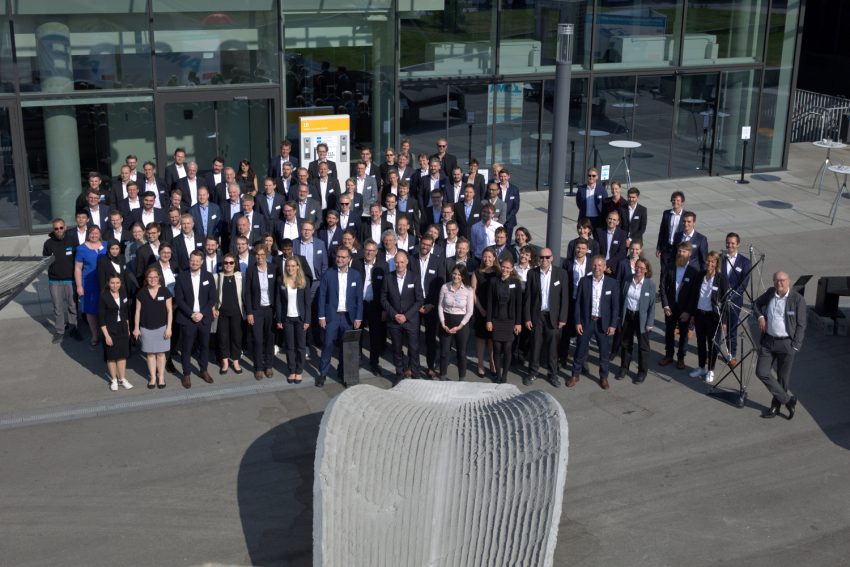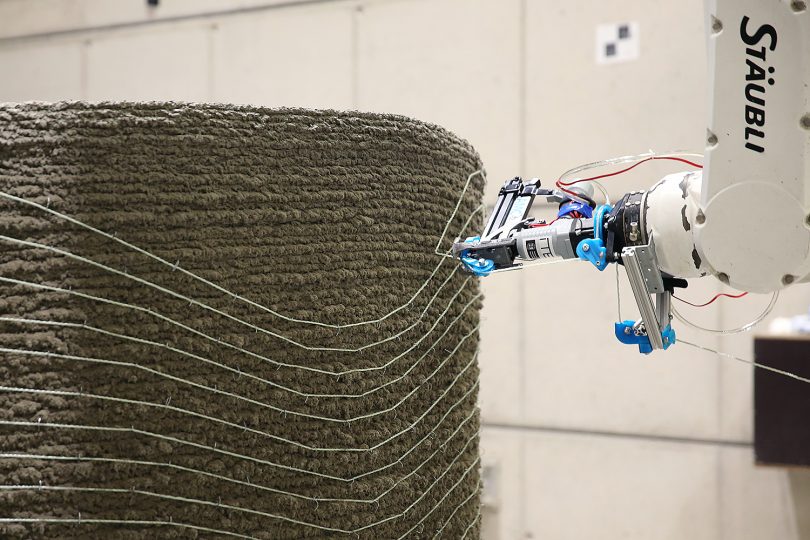A new era in sustainable construction Research network on 3D printing in construction enters second funding phase
- Research into 3D printing in construction at Technische Universität Braunschweig and Technische Universität München to be funded by the German Research Foundation for a further four years
- Network “Additive Manufacturing in Construction” (AMC) opens up new perspectives for the construction industry (SFB/TRR277)
- 3D printing process for building with clay and for flood protection
Conventional construction processes are characterised by inefficient material use, high environmental impact and stagnating productivity. With a growing world population and increasing demand for housing, the construction industry is reaching its limits. Given these challenges and the global significance of the construction sector as a major source of CO2 emissions and a huge consumer of resources, the question of the future is central: How can we create more living space and infrastructure with fewer materials and lower emissions?
This is the subject of the Collaborative Research Centre TRR 277 “Additive Manufacturing in Construction” (AMC) at the Technical University of Braunschweig and the Technical University of Munich. The German Research Foundation (DFG) has now extended the funding of the research network on 3D printing in construction by four years.

The scientists of the Collaborative Research Centre at a glance. Photo credit: TRR 277 AMC/Ida Mantey
Rethinking construction
“The continuation of the DFG-funded Collaborative Research Centre on 3D Printing in Construction is an important step towards an innovative and sustainable future for the construction industry,” says Angela Ittel, President of TU Braunschweig. “The research group is setting standards for excellence in construction technology and is actively shaping the transformation of the construction industry through advanced 3D printing technologies. The ongoing collaboration between the two universities not only successfully deepens supra-regional, interdisciplinary research, but also promotes knowledge and technology transfer.”
“3D printing, also known as additive manufacturing, is the key digital technology for the construction sector. This technology not only enables the layer-by-layer construction of three-dimensional components, as in conventional 3D printing, but also seamlessly integrates materials and manufacturing processes. This means that we are rethinking construction: which material can be used most effectively to make which component using which 3D printing process? Digitally controlled additive manufacturing processes thus open up new productive and environmentally friendly construction methods for the building industry,” explains Professor Harald Kloft from the Technical University of Braunschweig, spokesperson for the collaborative research centre.
The chance for a big impact
In the first four years of the collaborative research centre’s existence, the scientists have laid the groundwork for the large-scale application of additive manufacturing in the construction industry – for example, by investigating different 3D printing technologies, ways of integrating reinforcement or integrating 3D printing into the construction process chain. In the second funding period, subtitled ‘The opportunity of large impact’, the research programme will be expanded. In concrete construction in particular, the future challenge is to reduce the mass of components and to produce the necessary binders that turn concrete into concrete in the first place with low energy consumption and emissions. Clay as an earth-based material with innovative robotic processes is also included in the research programme. These processes offer new possibilities, for example in the construction of landscape infrastructure such as flood protection. In one sub-project, the researchers will quantify and optimise the environmental aspects of additive manufacturing using analytical life cycle assessment methods.
“Additive manufacturing is a scalable technology with global impact potential that enables more efficient, sustainable and customised buildings. Our subprojects are methodologically very experimental and require highly interdisciplinary cooperation between our scientists from the fields of civil engineering, architecture and mechanical engineering,” says co-spokesperson Kathrin Dörfler from the Technical University of Munich.
The research results of Transregio 277 AMC have the potential to fundamentally change the construction industry. The aim is to use 3D printing technologies to reconcile the requirements of economy and ecology, making construction more productive, environmentally friendly and affordable.
About the AMC Collaborative Research Centre
The DFG-funded Collaborative Research Centre TRR 277 Additive Manufacturing in Construction (AMC) at TU Braunschweig and TU Munich aims to play a key role in shaping the transformation of the construction industry into a digital and sustainable future. The focus is on the use of 3D printing technology (additive manufacturing) to develop resource-saving, low-emission and economical construction methods. Complex research questions in materials, process engineering, digital process control, modelling, design and construction will be addressed holistically by civil and mechanical engineers.
Further information: www.amc-trr277.de

